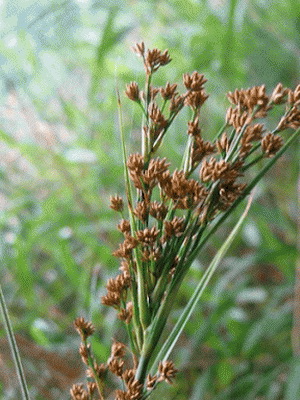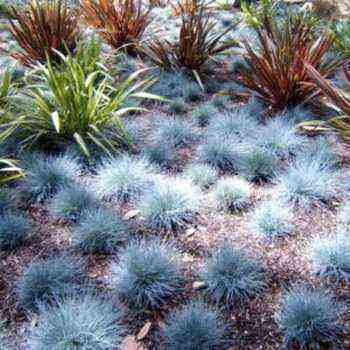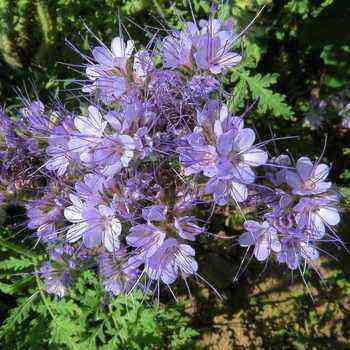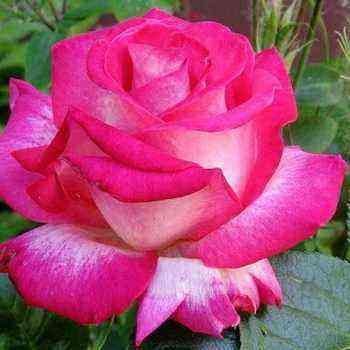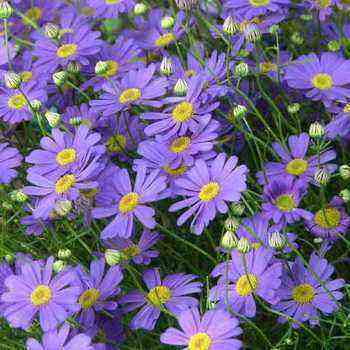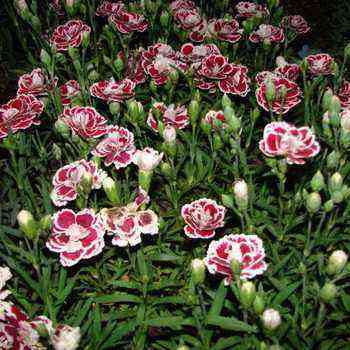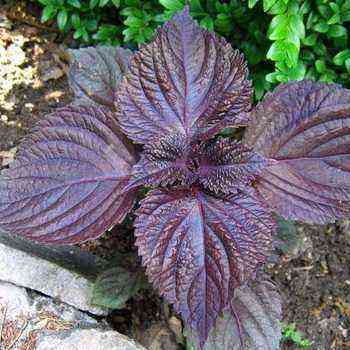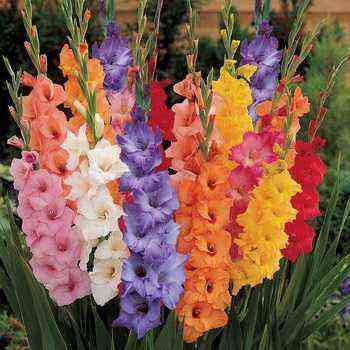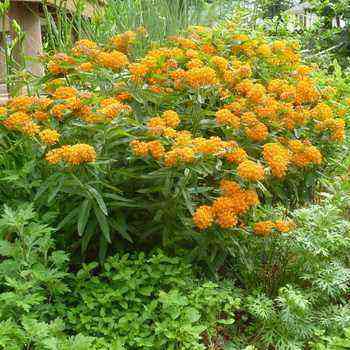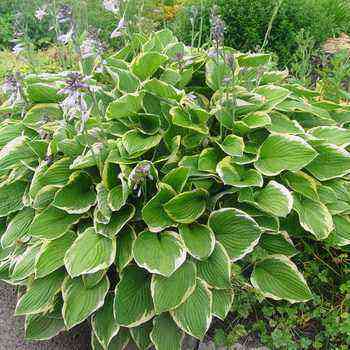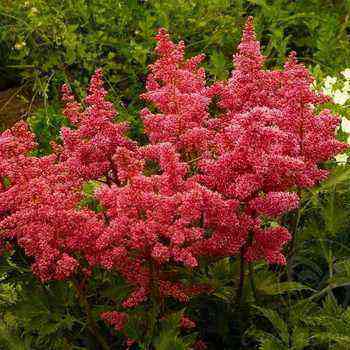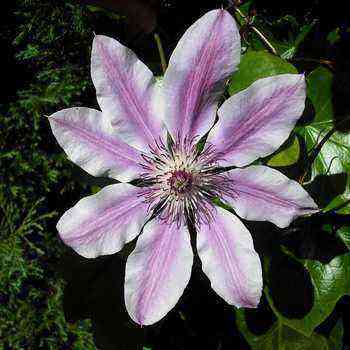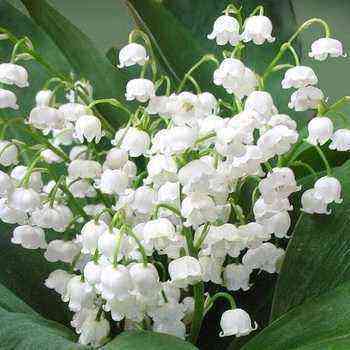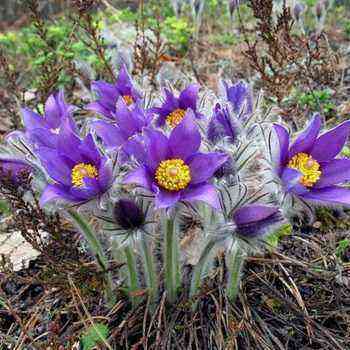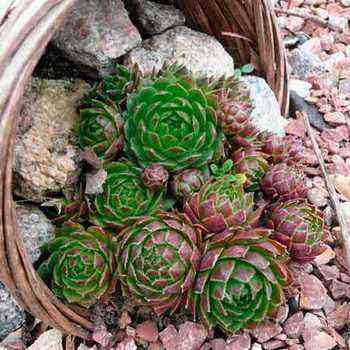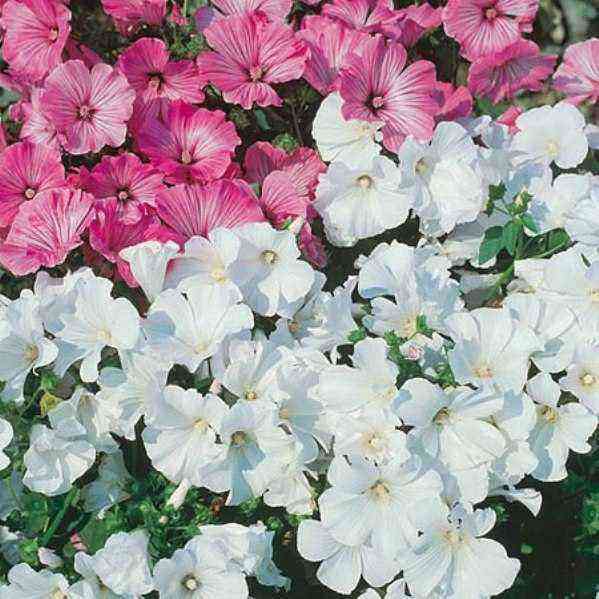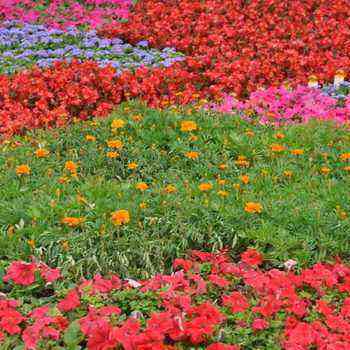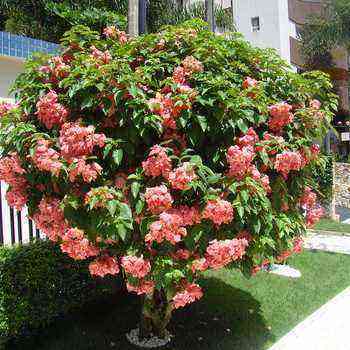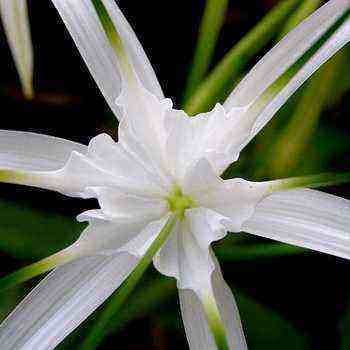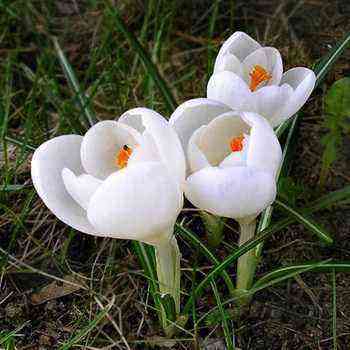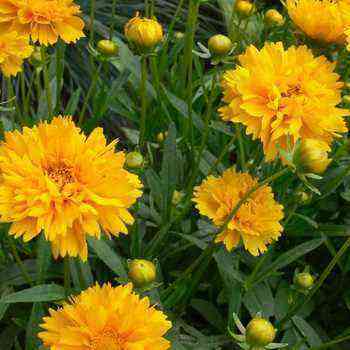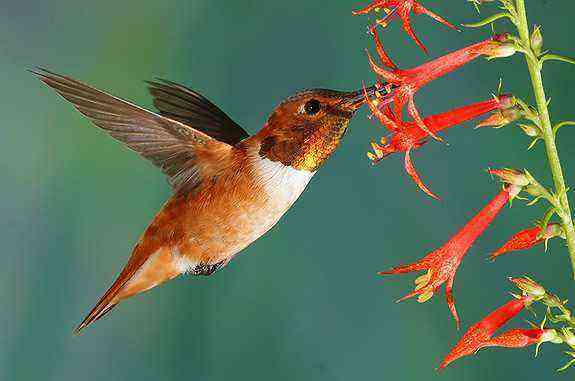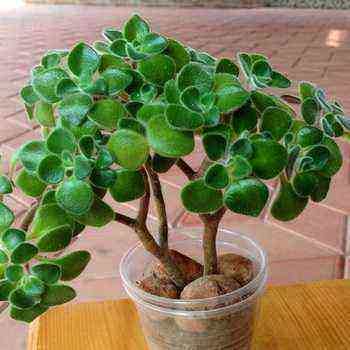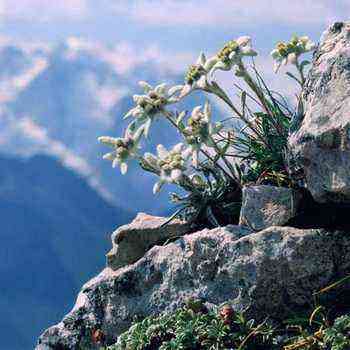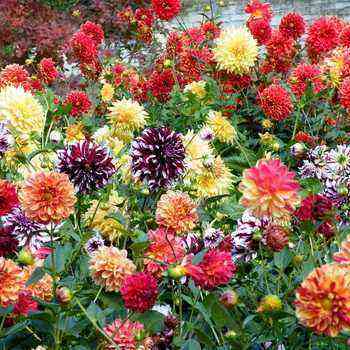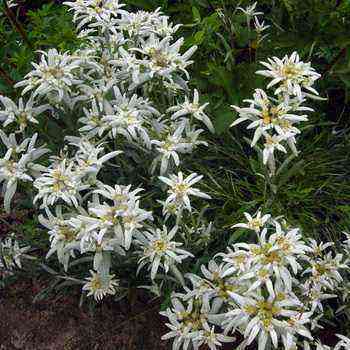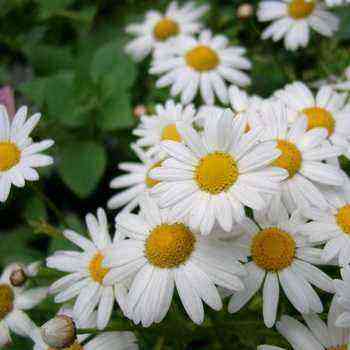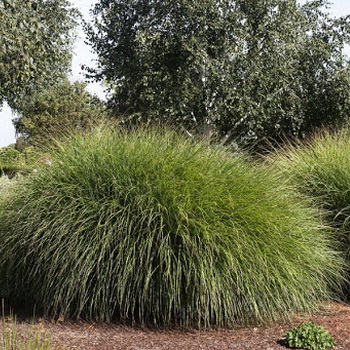
Air
Calamus (Acorus) – perennials of the aroid family (Agaseae) with thick branched and aromatic rhizomes. Leaves are linear, xiphoid. The stem is similar to a leaf, bears an inflorescence at the top, which seems to be lateral, since the inflorescence is a veil, directed upward and continues the stem. The inflorescence is a plump yellow ear with nondescript flattened flowers. Plants prefer moist soils.

A. ordinary (A. calamus). The rhizome is thick – up to 3 cm in diameter.
Leaves are bright green up to 100 cm tall. Found on the shores of reservoirs, in shallow water throughout the Northern Hemisphere. Serves to strengthen the banks. Grown in swamp gardens, in water to a depth of 20 cm, in containers.
Grades:
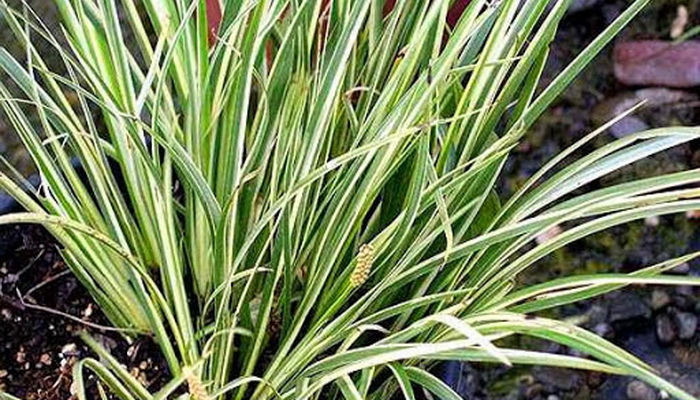
“Variegatus” – leaves with white longitudinal stripes. Non-aggressive.
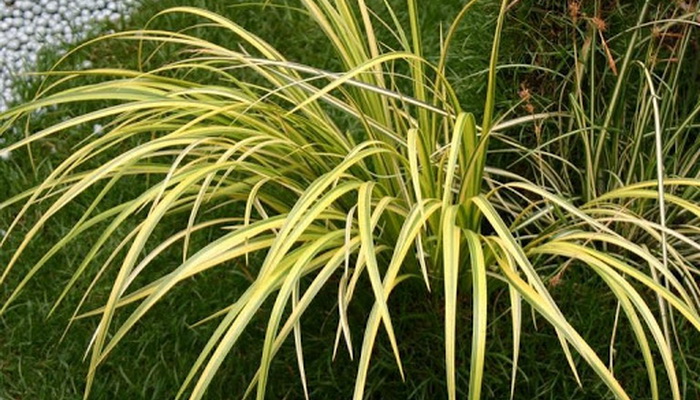
A. gramineous (A. gramineus). The rhizome is thinner than 1 cm. The leaves are narrow, up to 50 cm tall, dark green.
Found in Southeast Asia. Heat-loving. In central Russia, it often freezes out in the open field.
Recommended for aquariums, winter gardens, small ponds.
Grades:
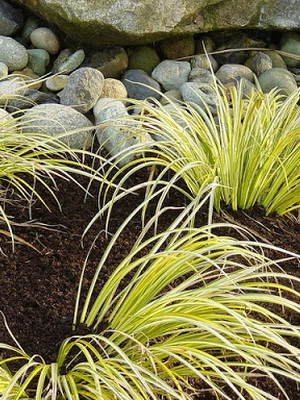
“Ogon” – half yellow leaf
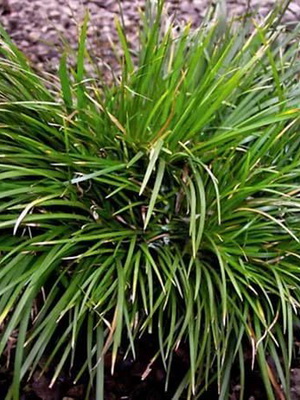
“Pusillus” – dwarf form, about 10 cm tall

“Variegatus” – the leaf is half white.
Hedgehog
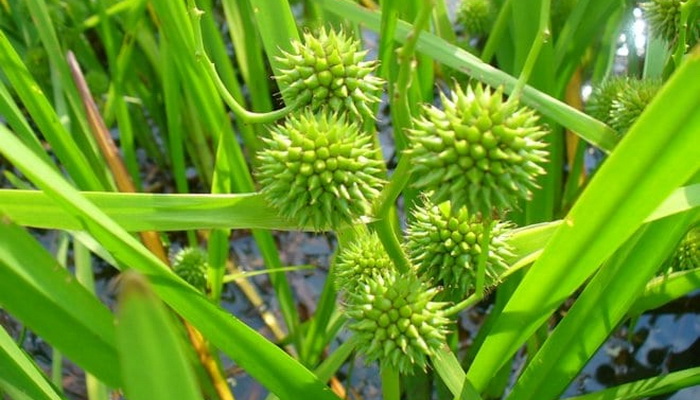
Hedgehog (Sparganium) – plump and soft perennials with rhizomes.
They belong to the Sparganiaceae family. They grow in shallow (and not very) water – from 5 to 50 cm. The protruding leaves are linear, grooved, with a pronounced keel. Some species have long underwater leaves. Inflorescence is apical, paniculate. The flowers are unisexual, collected in round heads on one plant. Male heads are small, yellow, dying off after flowering, female heads – after fruit ripening, they turn into green spiny balls. E. branched, or straight (S. erectum, or S. ramosum). The largest and most expressive species, up to 150 cm in height. The inflorescence is branched, with numerous female heads, up to 2 cm in diameter. A common European species, but also found in Siberia.
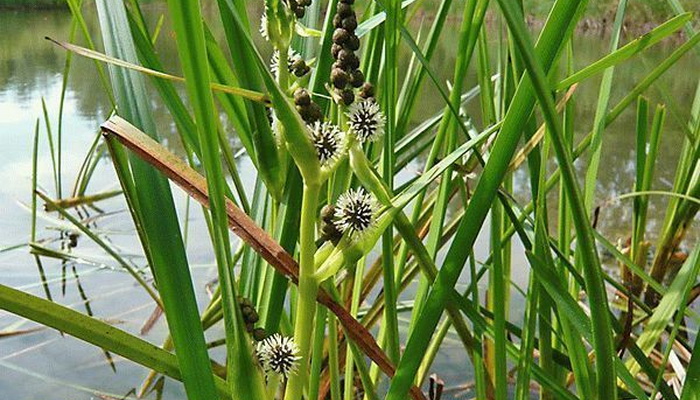
E. small (S. minimum). Weak thin plant.
Stem, floating or protruding, up to 80 cm long. Leaves are tender, drooping or floating. Inflorescence of several heads.
A common plant in the forest zone of the Northern Hemisphere.

E. simple (S. emersum, synonym for S. simplex). Up to 50 cm tall, in deep water it acquires a floating form. The inflorescence is simple, usually up to 10 female heads.
It is found in North America and Europe, including its Russian part.
Reeds
Bulrush (tuberkamysh and schenoplectus inclusive) (Scirpus, Schoenoplectus and Bolboschoenus) are perennials of the sedge family (Suregaseae) with cylindrical or triangular stems. Leaves are linear and (or) scaly. Paniculate inflorescence, collected from multi-flowered oblong spikelets. The flowers are bisexual; the perianth consists of small serrated bristles.

The species described below are winter-hardy, but there are also non-hardy species on sale, which must be taken indoors for the winter, for example, because spreading (S. cernuus, or Isolepis segpia).
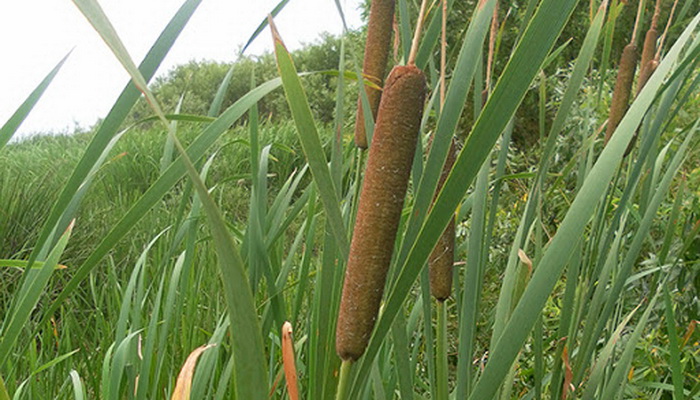
K. hooked, pointed (S. tycronatus, or Schoenoplectus tisgopatus).
The rhizomes are short, the curtains are dense. Stems up to 100 cm tall, bright green, clearly triangular. Leaves are scaly, brown, at the base of the stems. The inflorescence appears lateral due to the fact that the inflorescence leaf is directed vertically as an extension of the stem. Spikelets are not numerous, ovate, crowded, sessile, light brown. It is found in damp places in southern Europe, the Himalayas, Japan and China.
Grown in the coastal zone of water bodies.

K. forest (S. sylvaticus). Forms dense, bright green clumps, spreading out with short rhizomes.
Densely leafy stems, vegetative and flowering, up to 120 cm tall. Apical inflorescences are large, spreading, highly branched. Spikelets are small, brown, collected in 2-5 at the ends of the branches.
A common plant of the Northern Hemisphere, found in swamps, along the banks, in ditches and damp forests.
Used to secure the banks of reservoirs, for containers.

K. sea (S. maritimus, or Bolboschoenus maritimus).
Creeping rhizome with tubers. Stems up to 100 cm tall, spaced, triangular, leafy. Leaves are bright green, flat, up to 8 mm wide. Oblong brown spikelets are collected in groups: one central and several additional ones on peduncles of different lengths. A common plant of the Northern Hemisphere, grows on the banks of reservoirs, damp meadows, in ditches.
To strengthen the banks of reservoirs. Can be grown in submerged containers.
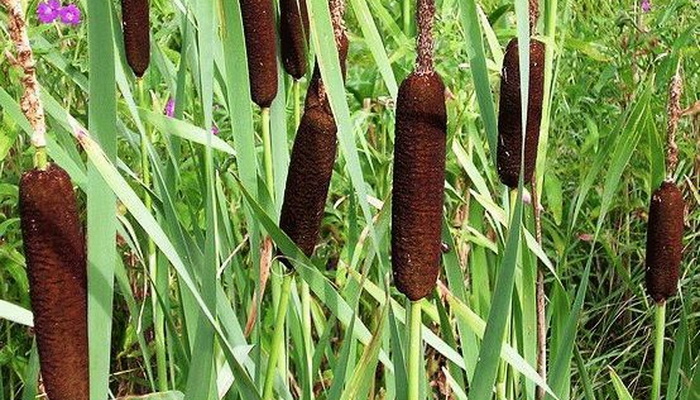
K. ordinary (S. holoschoenus, or Scirpoides holoschoenus, Holoschoenus vulgaris).
Forms dense turf. Stems up to 60 cm tall. Leaves at the base of the stems are scaly, some with a thin and short blade. One inflorescence leaf is directed upward, continuing the stem, the other is protruding, and the inflorescence seems to be lateral. Spikelets are small, greenish, later turning brown, collected in a few heads about 1 cm in diameter, sitting on branches of different lengths.
Occurs on the shores of shallow water bodies from southern Europe to India.
An interesting non-aggressive plant for the design of reservoirs.
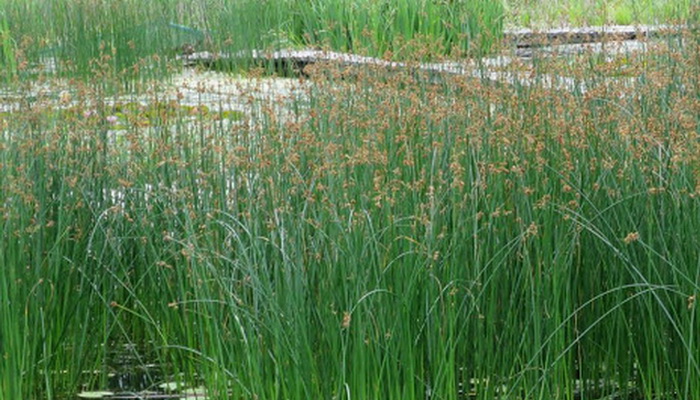
K. lake (S. lacustris, or Schoenoplectus lacustris).
A powerful plant with a thick horizontal rhizome. Stems are dark green, cylindrical, up to 250 cm tall. Leaves are scaly at the base of the stems. The inflorescence is apical, small, loose. Spikelets are oval, brown, large, up to 8 mm long, collected in bunches of 3-5.
Grows in shallow waters, the outskirts of swamps. Spreads heavily. Suitable for strengthening banks, for large bodies of water (up to a depth of 1 m), as well as for growing in containers.
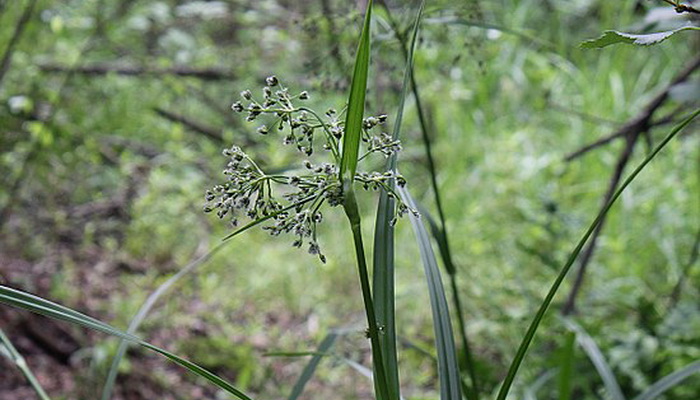
To. Full-bodied (S. cyperinus). The turf is dense.
Stems more than 150 cm tall, triangular, leafy, vegetative and with inflorescences. It resembles a forest tree, but the leaves are narrower, up to 1 cm wide. The inflorescence is very large and dense, with drooping thin branches. Spikelets are collected in groups of 2-15, bright brown. It is found in swamps, damp meadows, off the coast of water bodies in North America. Non-aggressive plant for the design of reservoirs.

K. Tabernemontana, or strong (S. tabernaemontani, or S. validus, Schoenoplectus tabernaemontani).
Similar to the lake and can be considered its subspecies, but less powerful, up to 150 cm tall, the stems are gray. The inflorescence is more compact.
More common in the black earth zone of Russia, in the Caucasus, in Western Europe.
Suitable for strengthening banks, for large bodies of water (up to a depth of 1 m), as well as for growing in containers.
Grades:
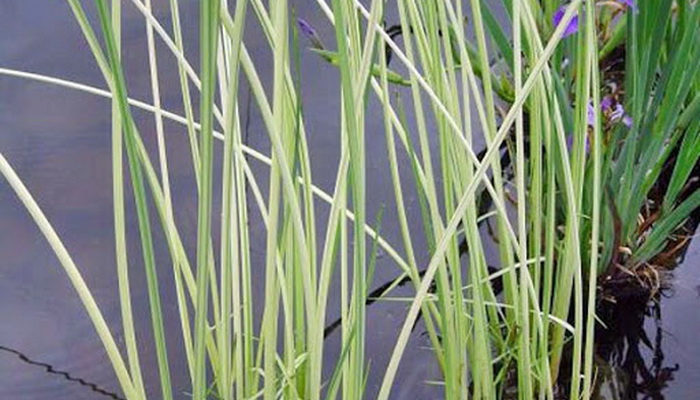
Albescens is a powerful variety with creamy longitudinal strokes on the stems.
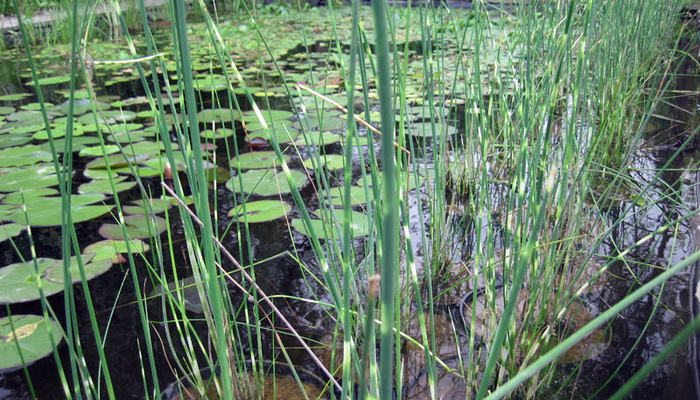
“Zebrinus” is a lower and weaker variety with transverse white stripes.

K. rooting (S. radicans). In general, it is similar to the forest forest, but, in contrast to it, it is dense sod. But it has long arcuate, vegetative shoots that hang to the sides and take root at the tops. Spikelets are single.
These garden ornamental perennial grasses are found in swamps, along the banks, in ditches and damp forests, but somewhat less frequently.
More decorative than woodland, looks good in containers in the middle of the reservoir.
Liriope spicata

Liriope spicata is a low, sprawling plant of the Liliaceae family with rosettes of linear leaves connected by rhizomes.
Leaves less than 1 cm wide. Peduncles up to 20 cm, shorter than leaves, inflorescence – brush. The flowers are arranged in whorls, small, pale, in lilac tones, the tepals do not grow together into a tube, but diverge from the base.
Homeland – Japan, China, Korea.
Groundcover, for curbs. A little common, although quite winter-hardy plant.
Grades:

‘Silver Dragon – with white longitudinal stripes on the leaves.
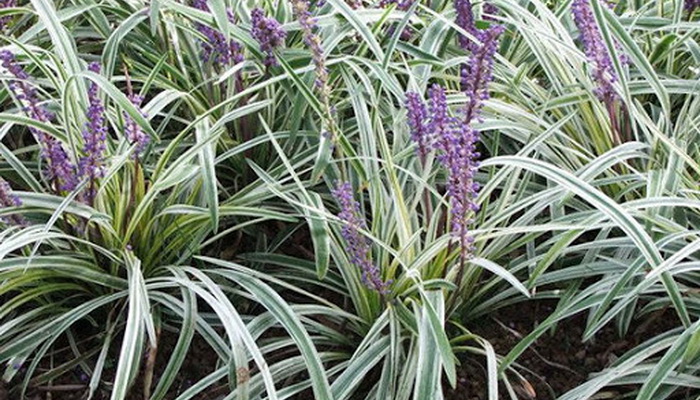
Another species widespread in horticulture – (L. muscari L. muscari) is distinguished by wider, up to 2 cm, leaves and tall, dense and bright inflorescences.
Found naturally in the same places, but not tested in the middle lane. It has a number of beautiful varieties. Both types can be offered under the name L. cereal (L. graminifolia). Liriopes are close to ophiopogons and can be included in this genus.
Sword grass ordinary
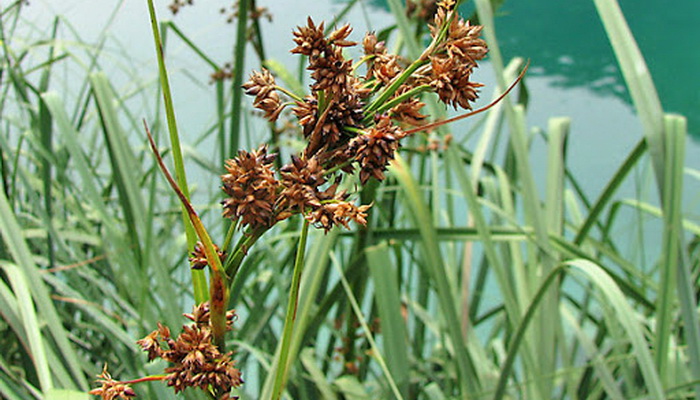
Common sword grass (Cladium mariscus) is a powerful perennial of the sedge family.
Forms dense grayish-green clumps up to 1 m in height. The stems are strong, leafy. Leaves are protruding, up to 0.5 m long and 0.5-10 mm wide, with cutting edges. The inflorescence is paniculate, long, narrow, consisting of brown spikelets collected in balls.
Inhabits shallow waters in Europe.
For reservoirs.
These photos show undersized and tall ornamental grasses, the names of which are listed above:
Ozhika
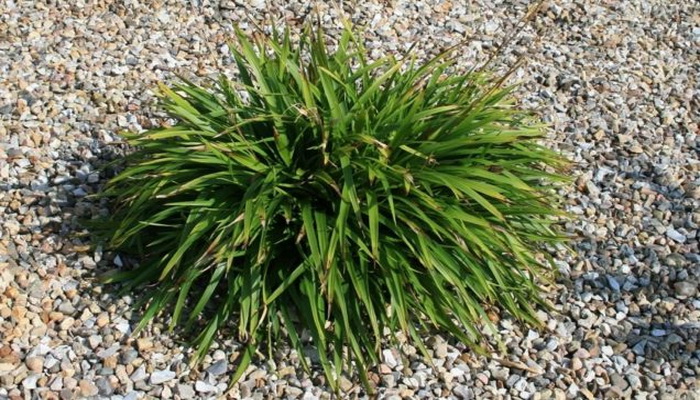
Ozhika (Luzula) – perennials of the family Sitnikovye (Juncaceae), more or less evergreen, remaining under the snow.
The leaves are clustered mainly at the base of the stem, are arranged spirally and form a funnel when viewed from above. They are relatively wide, grooved, with a flat, smooth surface; the veins are not distinguished. Sparse long and soft hairs sit along the edge. The inflorescence is apical, in the form of a loose panicle. The flower is bisexual and symmetrical with 6 brownish or greenish rigid leaves, 6 stamens and a column with 3 stigmas. The fruit is a capsule surrounded by a perianth.
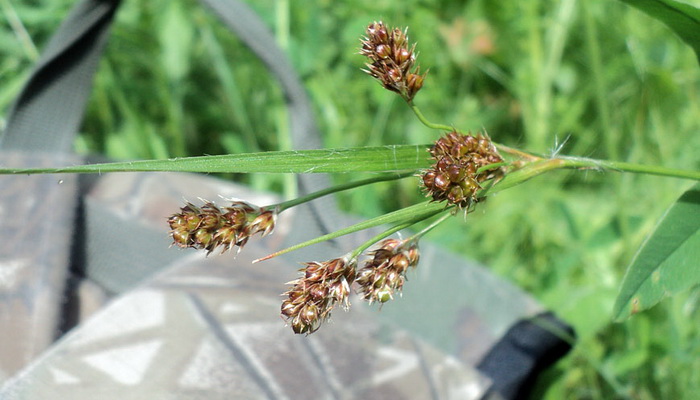
O. pale (L. pallescens, or L. pallida). The rhizome is shortened, the curtains are dense.
Leaves are erect, light green, up to 4 mm wide, with sparse hairs along the edges. Stems up to 40 cm tall. Inflorescences are oblong spikelets. The capsules are round, light brown.
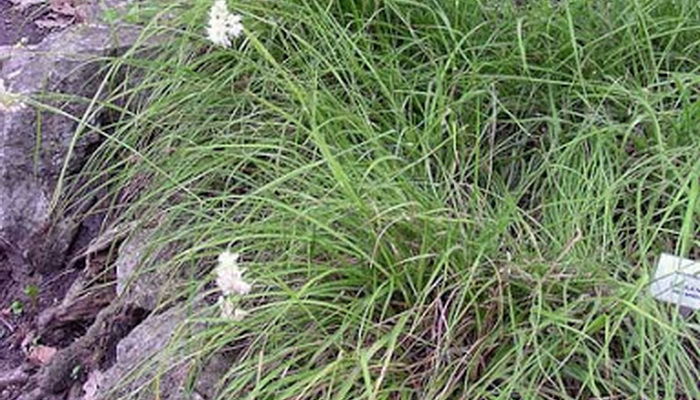
A beautiful European view – about. oat-like, or oak (L. luzuloides or L. nemorosa), distinguished by brownish flowers, can be found in our old parks, where it was naturalized. A common plant in damp meadows, light forests and roadsides of extratropical Eurasia.
A neat unpretentious plant.

O. hairy (L.pilosa). Forms loose tufts.
Leaves up to 1 cm wide, spreading, shiny, with long hairs at the base. Stems up to 35 cm tall. The inflorescences are openwork, its branches are spread out, even bent down towards the end of flowering, unbranched, with single flowers.
A common plant of the middle lane, more often found in forests with rare grass in Europe, Siberia, and the Caucasus.
Unpretentious plant, suitable for shady flower gardens with small plants, rock gardens.
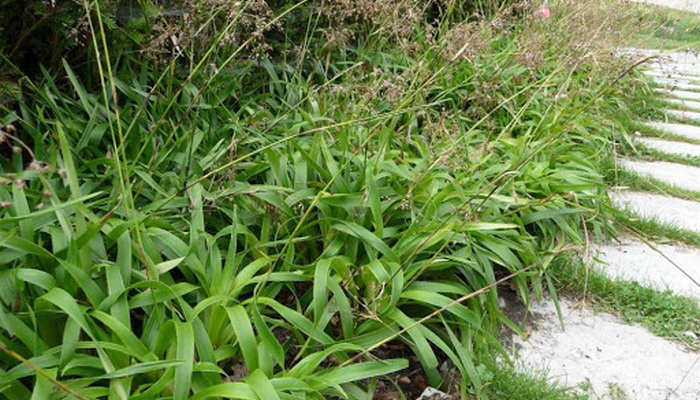
O. forest (L. sylvatica). Large evergreen plant forming lush rosettes connected by rhizomes.
Leaves are shiny, grooved, curved, more than 1 cm wide, with hairy edges. Stems are slender, up to 60 cm tall. Inflorescences are paniculate, loose, with light brown small flowers, collected in several pieces on threadlike branches.
Found in the forests of Western Europe, the Caucasus. Winter hardiness.
One of the most decorative ozhik, suitable for shady flower beds, borders and rockeries.
Grades:
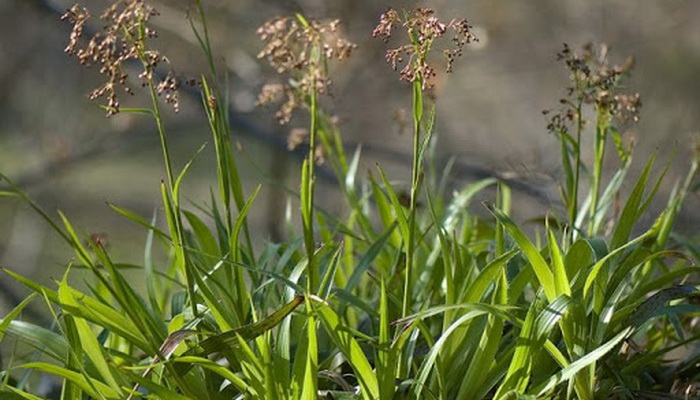
“Aurea” (“Hohe Tatra”, “Tatra Gold”) – with apple-green young leaves that turn yellow by winter.
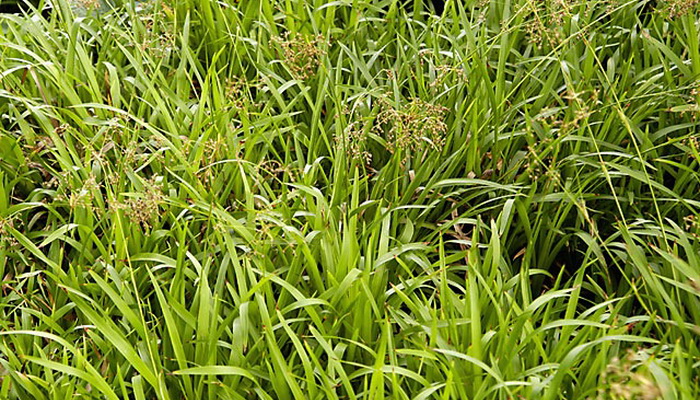
“Auslese” – up to 30 cm tall, leaves are light, tightly twisted.
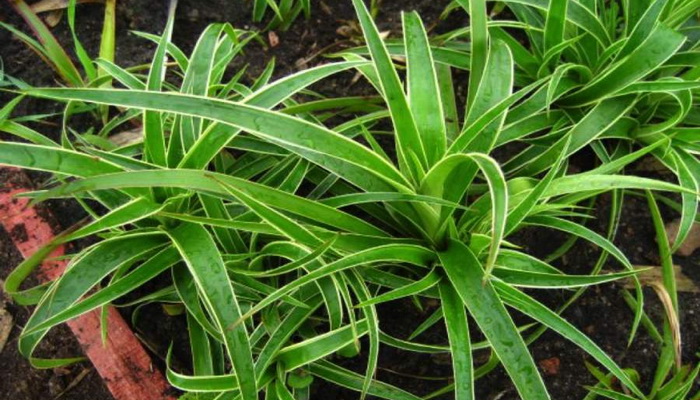
“Marginata” – leaf edge with a narrow creamy white border.
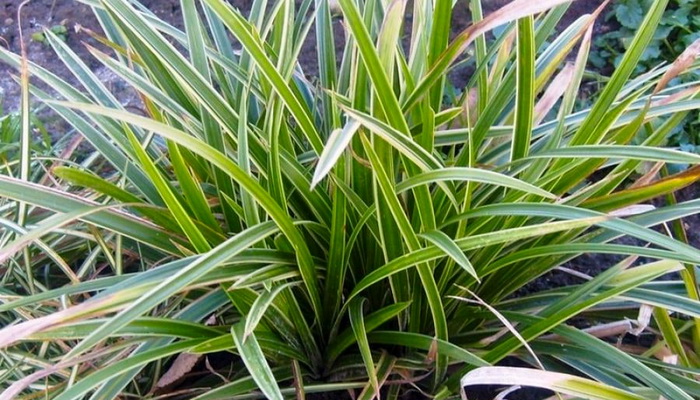
“Variegata” is a rare variety with a yellow border on the leaves and yellow flowers).

O. multiflora (L. multiflora). The turf is dense, up to 40 cm in height.
Leaves are protruding, up to 6 mm wide, densely hairy. The inflorescence is relatively dense, with branches sticking upwards. The flowers are dark brown, collected in cylindrical groups of 8-16. Distributed throughout the Northern Hemisphere, very variable, most likely a complex of species. A closely related species, distributed mainly in Europe, is about. plain (L. campestris), characterized by noticeable rhizomes and rounded groups of flowers on splayed branches.
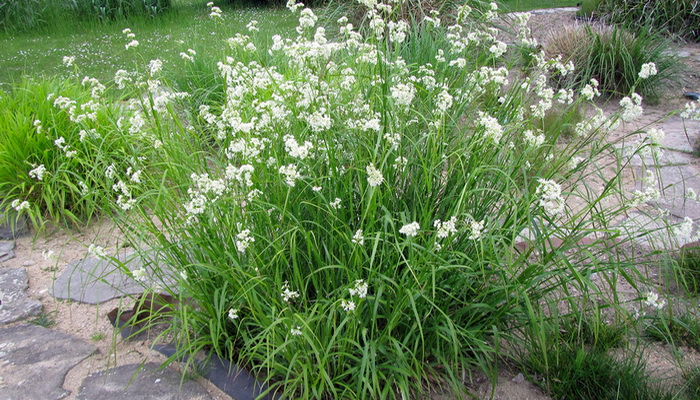
O. snow (L. nivea). The plant is loose-soddy, with numerous narrow, up to 4 mm, leaves, pubescent with long white hairs.
Peduncles up to 60 cm tall, with drooping lush inflorescences. The flowers are pure white, collected in groups.
Found in the mountain forests of Europe. Winter hardiness.
A very beautiful, delicate plant for shade flower beds, especially in bulk.
Ophiopogon
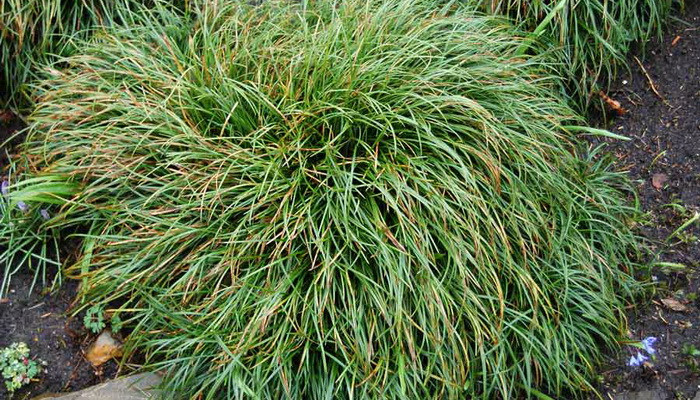
Ophiopogon is a plant of the Liliaceae family. A genus close to lyriopa differs in that the perianth leaves grow together at the base, forming a short tube.
Heat-loving perennials of Southeast Asia, suitable for the Black Sea coast. Although some species are grown with varying success in the middle lane.

O. flat-fired (O.planiscapus). Forms dense clumps up to 20 cm high, growing with the help of rhizomes.
Rosette leaves, gramineous, spreading, 4-6 mm wide. Inflorescences with whorls of pale lilac flowers. The fruits are round, bluish-black.
Groundcover, suitable for curbs.
Grades:
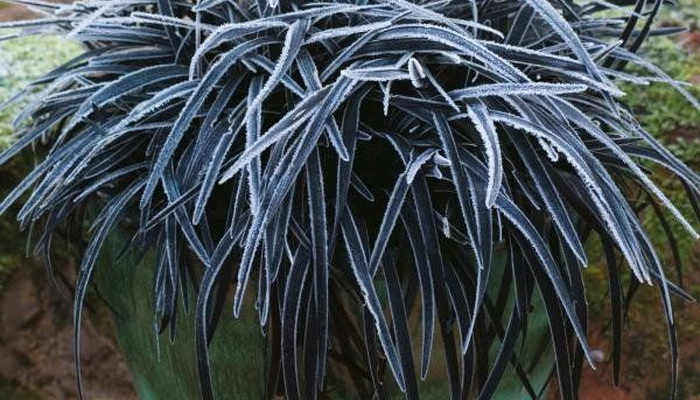
Nigrescens (or Ebony Knight, Arabicus) is a popular variety with dark purple, almost black leaves.
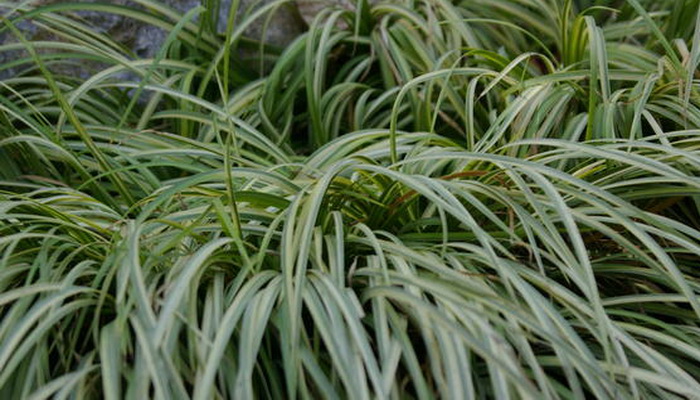
O. umbellate (O. umbraticola). The leaves are dyne, but not wider than 2 mm. Inflorescences are loose, with small flowers giving rise to blue berries.
Groundcover.
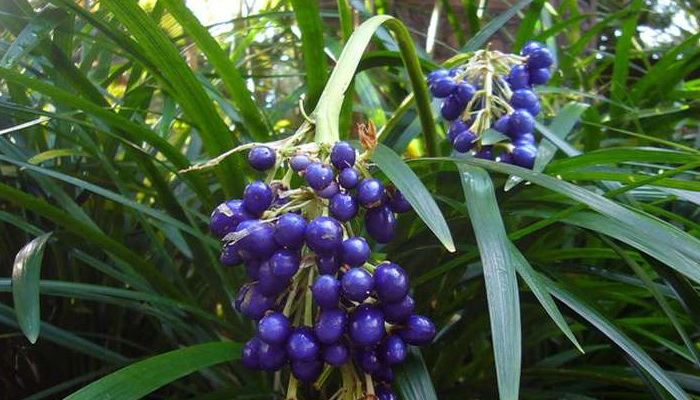
O. Japanese (O. japonicus). Small plant, up to 15 cm tall, leaves no wider than 4 mm. The fruits are bright blue, much more beautiful than flowers.
Perhaps the most winter hardy. Withstands short-term frosts down to -15 ° С.
Groundcover, suitable for curbs.
Alpine poohonos
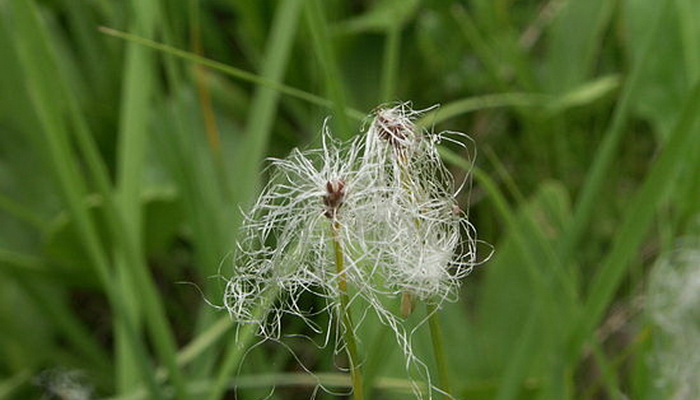
Alpine poohonos (Trichophlorum alpinum) is a representative of the sedge family (Suregaseae).
It spreads out, forming curtains up to 30 cm high from triangular stems. Leaves in the form of scales, only the uppermost with a bristle plate up to 1 cm long. Inflorescence – apical spikelet less than 1 cm with 10-15 flowers. Perianth of 6 white setae, which elongate with fruit. Grows in swamps and swampy shores of water bodies in the temperate zone of the Northern Hemisphere.
For swamp gardens.
Cotton grass
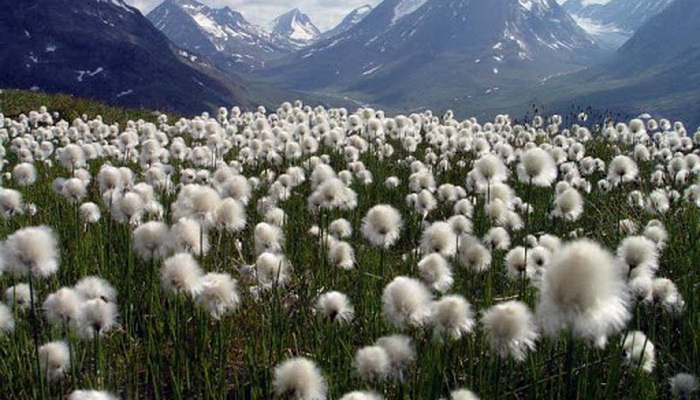
Fluffy (Eriophorum) – perennials of the sedge family (Suregaseae).
The leaves are similar to those of related sedges, for the most part crowded at the base of the peduncles. A characteristic feature is the perianth, consisting of numerous hairs that elongate with fruits and turn the spikelet into a large delicate puff.
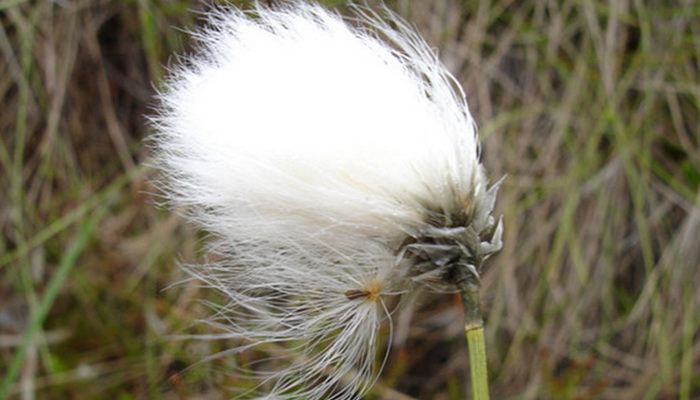
P. vaginal (E. vaginatum). Forms a dense turf – a hummock.
The leaves are narrow, triangular, protruding. Peduncles are somewhat longer than them, with swollen, scaly leaves and single spikelets sticking out at the top. Puffs are snow-white, rounded, up to 4 cm long, appear in June. Common plant of raised bogs and boggy pine forests of Eurasia.
Plant for peat bog gardens.

P. mnogokoloskovaya, or narrow-leaved (E. polystachyon, or E. angustifolium).
It spreads quickly with long rhizomes. Leaves 3-5 mm wide, bluish-green, grooved. Peduncles up to 70 cm tall. Spikelets in inflorescences 3-7, drooping on hairy twigs. Together with down, their length reaches 4 cm. Snow-white puffs. A common plant in Russia and Western Europe, common in sedge bogs, damp meadows, and the banks of water bodies.
To secure the banks. For containers in ponds.
A similar and also common species in our country – n. Broad-leaved (E. latifolium) – is distinguished by the bright green color of wider (up to 8 mm) leaves.

P. Chamisso, or reddish (E. chamissonis, or E. russeolum).
It spreads with long rhizomes, vegetative and flowering shoots are placed. The leaves are filiform, triangular. Peduncles up to 70 cm tall, single spikelets. Puffs are rusty-brown, of different shades, up to almost white, rounded, up to 4 cm long.
Grows in swamps, tundra and mountains of Eurasia and North America.
For bog gardens with peat soil.
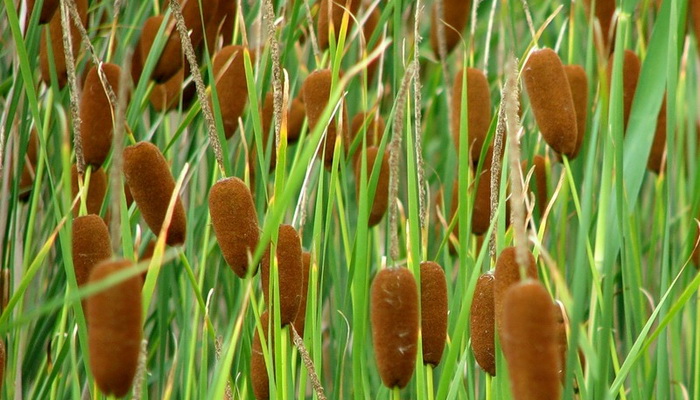
P. Scheuchzeri (E. scheuchzeri). Forms colonies of vegetative and flowering shoots, spreading out with long rhizomes.
The leaves are grooved or twisted, bright green. Peduncles up to 50 m tall, spikelets single, apical. Puffs are snow-white, rounded, up to 4 cm long. Occurs in the tundra swamps of Eurasia and North America.
For bog gardens with peat soil.
Rogoz

Cattail (Typha) – large perennials of the family Cattail (Typhaceae).
A common plant in shallow waters and damp places with creeping rhizomes, forming continuous thickets. The leaves are flat, linear, soft. The flowers are unisexual, very small, with a perianth of hairs, collected in two cylindrical inflorescences located one above the other: from above there are male flowers (staminate), from below – female (pistillate). After flowering, the male flowers fly around, and the female inflorescence turns into a brown velvet “cone”.
Often this ornamental herbaceous perennial plant for the garden is found under the name reed.
Winter hardy, unpretentious. Female inflorescences, collected in green, are suitable for bouquets, including dry ones, especially after fixing with hairspray.
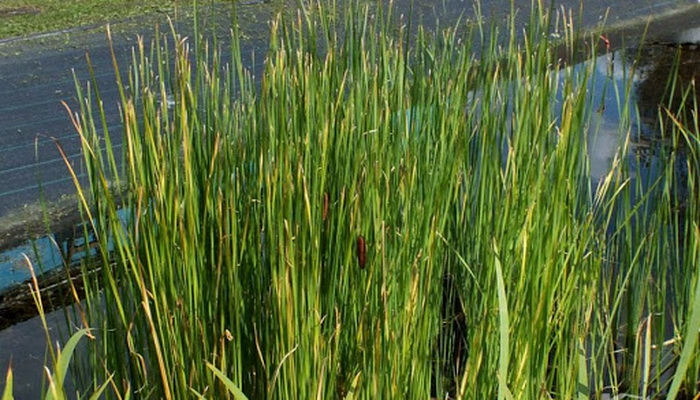
R. graceful (T. gracilis). From a botanical point of view, it is a synonym for p. Laxman.
In practice, this name can be considered commercial, since any small cattails, both with elongated and almost round “cones”, are called so on sale. Among the small cattails, there is a lot of confusion created by the joint efforts of taxonomists and gardeners.
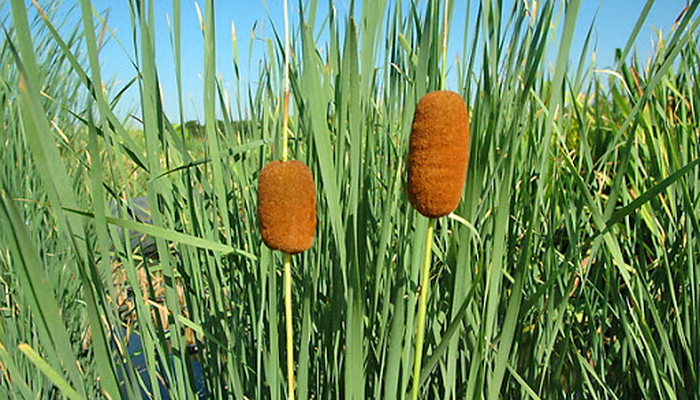
R. Laxman (T. laxmannii). Relatively low, up to 100 cm, graceful plant.
Leaves up to 5 mm wide. The inflorescence is hidden among the leaves. The pistillate part of the inflorescence is oblong, short, 4-12 cm long, several times shorter than the staminate, 1-6 cm away from it. The axis of the inflorescence is hairy under the male flowers. Suitable for small ponds, especially when kept in containers.
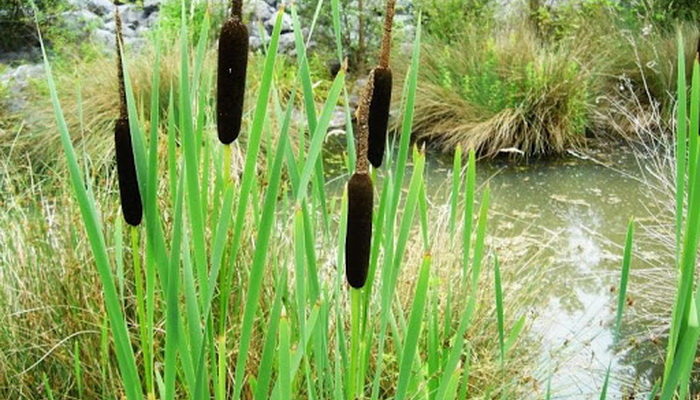
R. narrow-leaved (T. angustifolia). The rhizome is thick, up to 3 cm in diameter, the stems are usually up to 200 cm tall, although they can be higher in the southern regions.
Leaves are dark green, usually larger than the inflorescence, 4-6 (10) mm wide. The male and female parts of the inflorescence are spaced 3-8 cm.
It grows everywhere, is aggressive, overgrows water bodies, forming a raft.
For anchoring the banks of large natural reservoirs. For containers.

R. broadleaf (T. latifolia). Similar to r. narrow-leaved.
Differs in wider – about 20 mm, grayish-green leaves. Parts of the inflorescence practically merge. It often grows with p. narrow-leaved, forming hybrids. Aggressive.
For anchoring the banks of large natural reservoirs. For containers.
Grades:

“Variegata” – with longitudinal white stripes on the leaves. Relatively low and non-aggressive – it grows slowly.
Sitnik
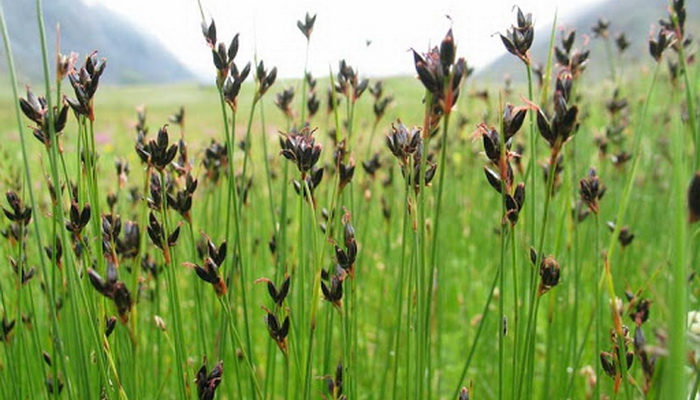
The rump (Juncus) is a plant of the rump family (Juncaceae).
Nurseries may offer a variety of local species, many of which are similar. The listed species are perennial. Plants with soft, rounded stems and paniculate inflorescences. The inflorescences are apical or appear lateral, because the inflorescence leaf is directed upward, as if continuing the stem. Flowers with inconspicuous perianth of 6 rigid, scaly, usually brownish leaves. The fruit is a box with three leaves. Prefers wet habitats.
Some rushes are grown as indoor plants and taken out in the garden for the summer.

C. curved, or gray (J. inflexus, or J. glaucus). The rhizome is short.
Stems are glaucous, up to 100 cm in height, 2-4 mm in diameter, close together. Leaves at the base of the stems, scaly, red-purple, shiny. The inflorescence is paniculate, large and loose, it seems lateral due to the fact that the inflorescence leaf is directed upwards. The flowers are greenish-rusty.
European plant, found in central Russia. It grows on the banks of rivers, streams, in ditches.
More drought-resistant than with. spreading.
It is interesting with lush bunches of protruding gray-gray shoots. For the design of reservoirs, watered flower beds, for growing in containers.
Grades:
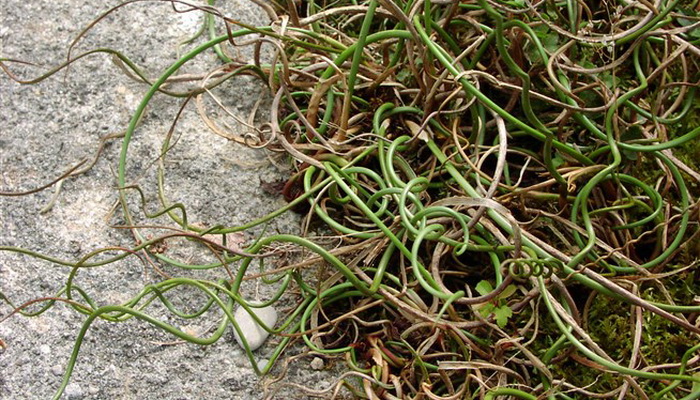
“Afro” (“Blue Medusa”) – low, the shoots are spirally twisted and arranged chaotically.
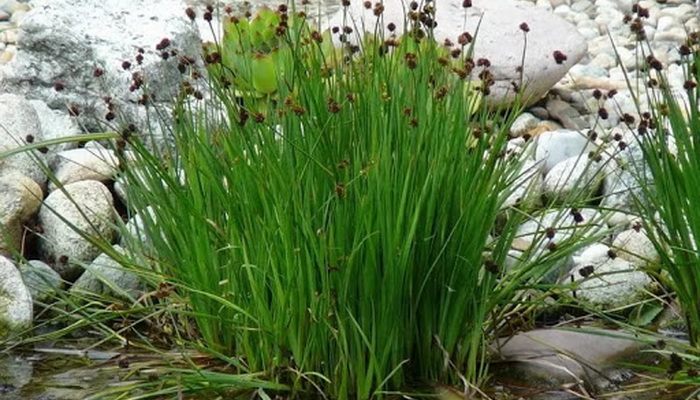
C. sword-leaved (J. ensifolius). Forms dense curtains up to 50 cm high.
Leaves are flat, up to 6 mm wide, bright green, clustered at the base of the stems. The inflorescence is apical, with a few large, about 1 cm in diameter, and dense heads of dark brown flowers.
Notable rump from North America and East Asia.
It grows well and reproduces by self-seeding in damp places.
For the shores of reservoirs, irrigated flower beds.
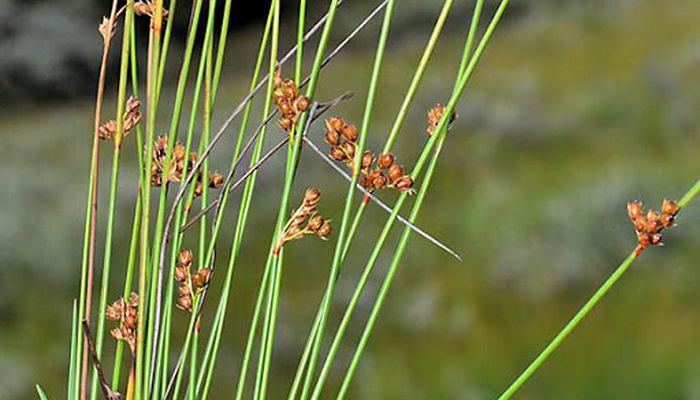
C. filiform (J. filiformis). Rhizomes are long, horizontal.
Stems rise in regular rows, round, clear green, up to 60 cm tall and 1.5 mm in diameter. Leaves – brown scales at the base of the stems. Inflorescence of 3-10 flowers, lateral. The flowers are light brown.
A common plant in the middle lane.
For the shores of reservoirs, containers.
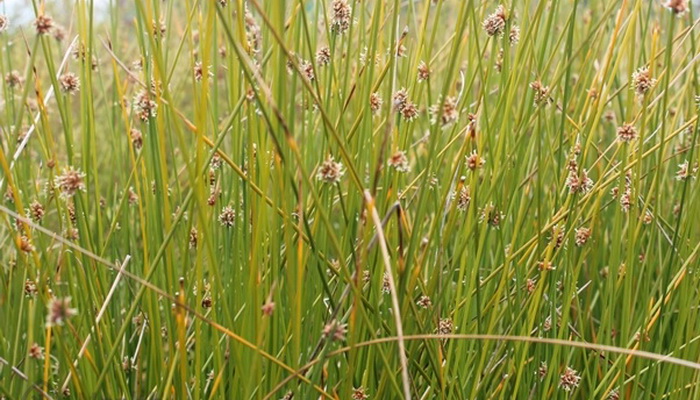
C. spreading (J. effusus). Perennial with a short, horizontal rhizome.
Stems are clustered, up to 120 cm in height and 2-4 mm in diameter, round, dark green, remaining under snow. Leaves – brown scales at the base of the stems. The inflorescence is spreading, lateral. The flowers are brown, red. Widely distributed in Eurasia, introduced to other parts of the world. It is highly variable, and numerous forms are distinguished in different parts of the range, which causes confusion in nomenclature. So, American and Japanese plants can stand out in the village. deceptive (J. decipiens).
Wild form is a common but showy plant in coastal areas and wetland gardens. Varieties derived from different geographic forms may not be very hardy.
Can be grown as a houseplant.
Grades:
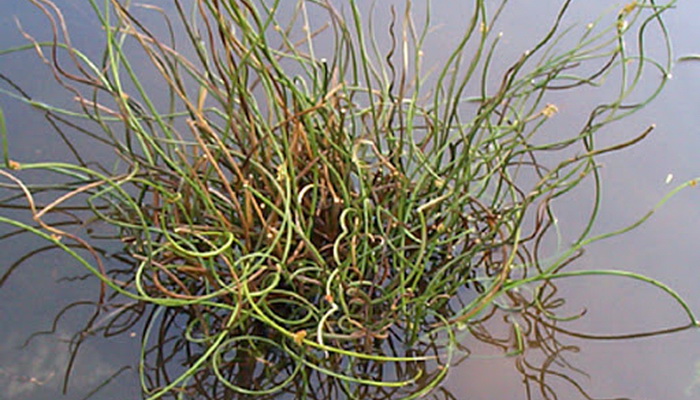
“Blonde Ambition” – spirally twisted thin stems, yellow with green strokes.

“Carman’s Japanese”, “Quartz Creek” – selected clones of the wild: tall, bright green.

“Frenzy” (“Limelight”) – low, up to 20 cm, and thin, with twisted stems painted with longitudinal yellow strokes.
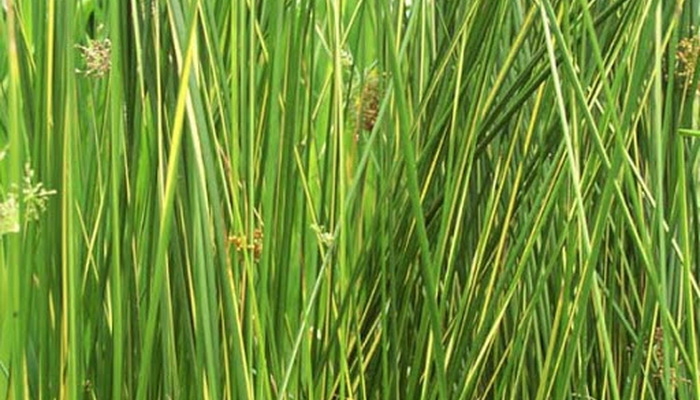
“Gold Strike” – Stem with longitudinal yellow stripes.
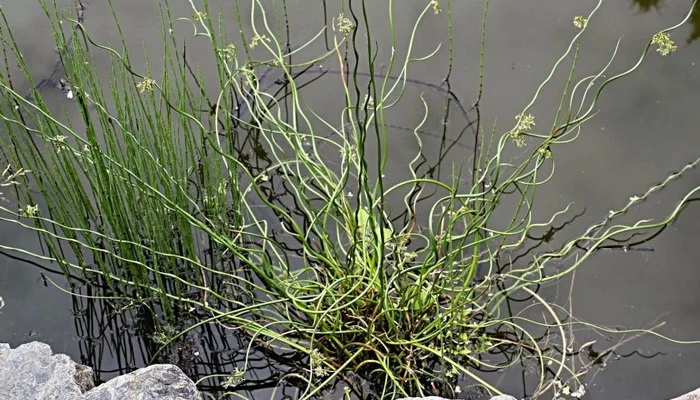
“Spiralis” (“Big Twister”, “Curly Wurly”) is a widespread variety with spirally twisted stems directed in different directions, reproduced by sowing seeds, due to which the growth (average 35 cm) and the thickness of the shoots vary in different accessions …
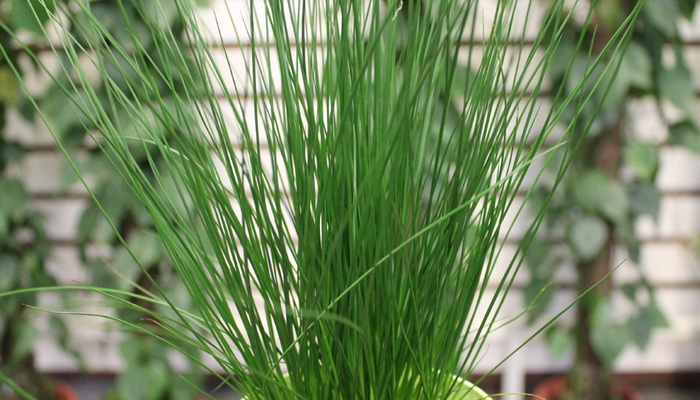
The dwarf “Spiralis Nana” and the powerful, up to 100 cm tall, “Unicorn” form, perhaps just selected clones.

C. crowded (J. conglomeratus). The rhizome is short.
Stems close together, dark green, reaching 60 cm in height and 2-4 mm in diameter. Leaves are scaly, brown, covering the base of the stems. Inflorescences appear lateral due to a vertically directed inflorescence leaf, paniculate, dense, rounded. The flowers are light brown. A common plant in central Russia for a variety of damp places.
For ponds and swamp gardens.
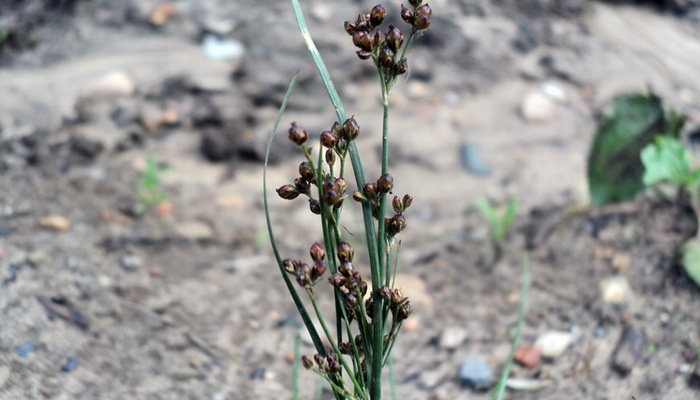
C. oblate (J. compressus). It grows as a rhizome, forming dense clumps.
Stems are flattened, up to 50 cm tall. Leaves are dark green, flat or grooved, up to 1 mm wide. The inflorescence is apical, rather wide and spread out. The flowers are light brown, solitary at the ends of the branches. Distributed in meadows, along the shores of Eurasian reservoirs.
For flower gardens, swamp gardens.
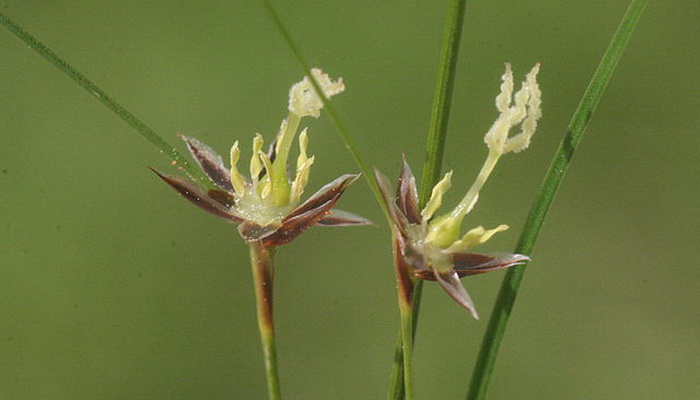
C. tripartite (J. trifidus). Thin, graceful dense sodny rush up to 40 cm tall.
Leaves are bristly, flat or grooved.
The inflorescence is apical, small, compact, of several flowers, surrounded by noticeable inflorescence leaves. Occurs in the tundra and highlands, on stony placers. Distributed throughout the Northern Hemisphere.
For swamp gardens, rockeries.

C. jointed (J. articulatus). Dark green perennial with a horizontal rhizome and densely standing stems up to 50 cm tall.
The stems are leafy to the middle. The leaves are thick, semi-cylindrical with transverse septa. The inflorescence is apical, branched.
Brown inflorescences of 3-12 flowers sit in the forks. The capsule is pointed, shiny, longer than the perianth.
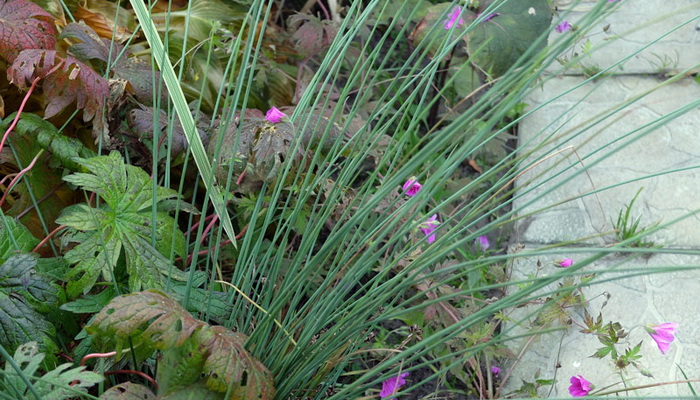
A similar view – p. alpine (J. alpinus) – differs in smaller inflorescences. A common plant in the middle lane that lives on damp banks, meadows, and roadsides.
For the design of reservoirs.
Sitnyag
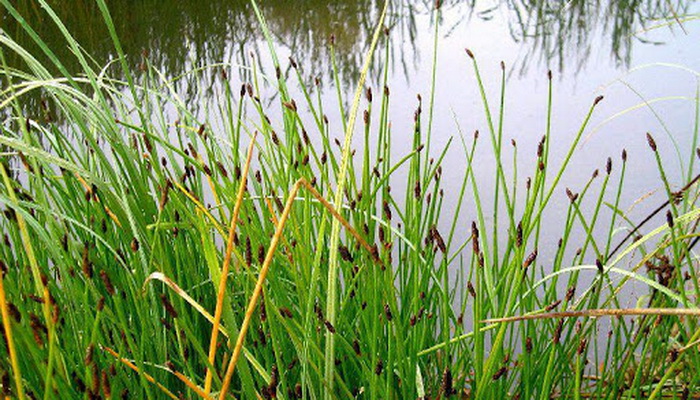
Sitnyag or swamp (Eleocharis) are rhizome perennials of the sedge family (Suregaseae).
Stems glabrous, cylindrical. Leaves are scaly at the base of the stems. The flowers are bisexual, with a perianth of bristles, collected in an oblong spikelet sticking out at the end of the stem. They grow in shallow water, on damp soils. Nurseries may offer a variety of local species that are fairly similar to each other.
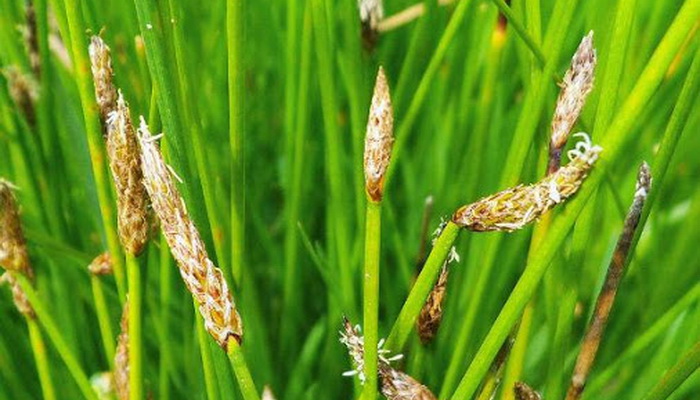
C. marsh (E. palustris). Plant up to 50 cm tall, with dark or bluish stems apart. Spikelets are brown, up to 15 mm long.
It is found everywhere.
For the design of reservoirs, containers.
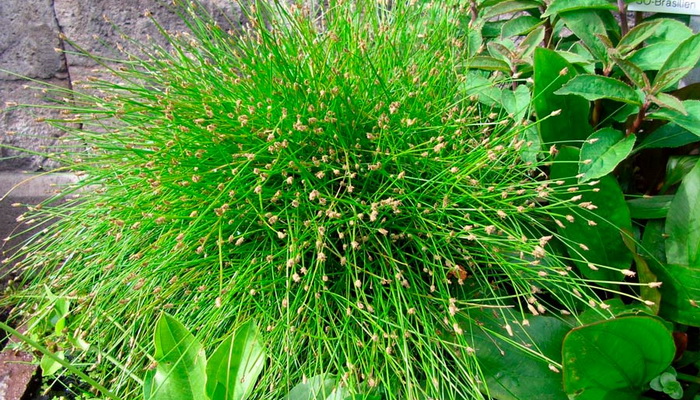
S. Montevidensis (E. montevidensis). Dense sod, connected by rhizomes, forms a continuous cover.
Stems are green, up to 50 cm tall. Spikelets up to 12 mm long. A powerful plant that retains its fresh appearance until late autumn.
Homeland – America (North and South), grows in damp places.
For the design of reservoirs, containers.
Feed
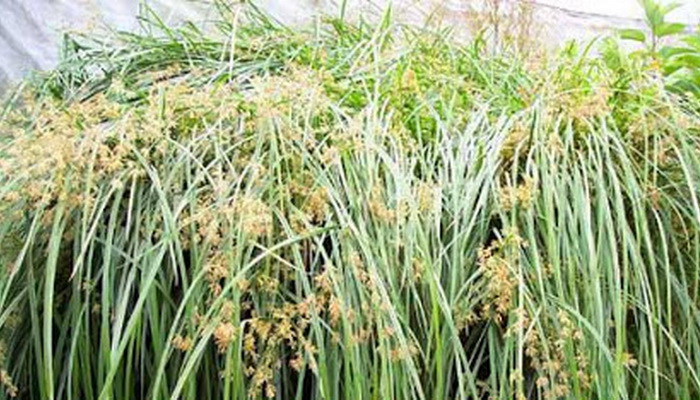
Syt (Cyperus) is a plant of the sedge family (Suregaseae).
Stems are triangular or rounded. Leaves, crowded at the base, flat, keeled. The inflorescence is apical, paniculate, with a fan of long adherent leaves. The flowers are bisexual, without perianth, collected in long linear spikelets, which, in turn, are collected in groups at the ends of the inflorescence branches.
Mostly thermophilic evergreens that can only be kept in open water during warm periods. In winter, they are stored as indoor plants.
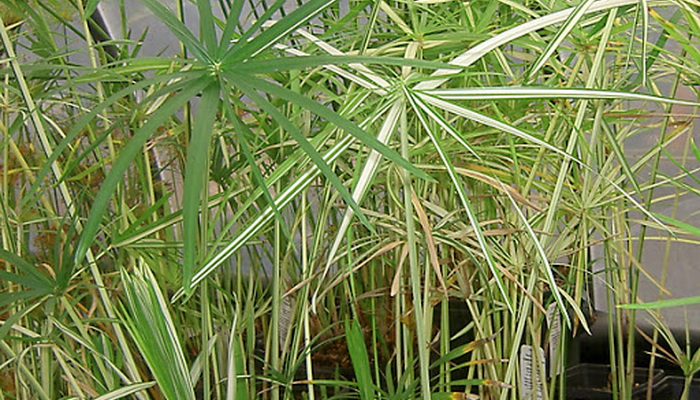
Popular in this capacity with. alternate-leaved (C. alternifolius), papyri (C. giganteus, C. papyrus, C. isocladus, C. haspan).
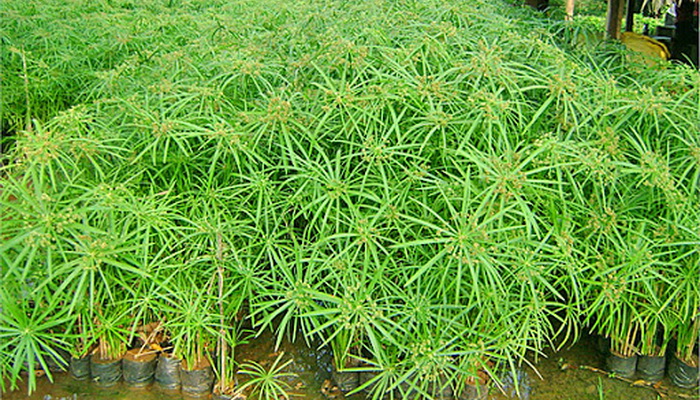
C. long (C. longus). Rhizome spreads, forming dense, bright thickets.
Stems are triangular, up to 130 cm tall. The branches of the inflorescence reach 35 cm in length, with 5-6 leaves at its base. Spikelets in bunches of 3-10, narrow, up to 1.5 cm long, rusty brown.
Found in Western Europe, Transcaucasia, Himalayas.
For the design of reservoirs. Stored immersed in winter.
Uncinia red
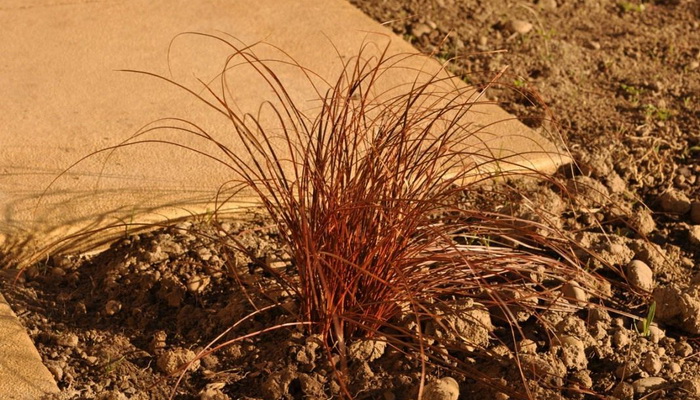
Red uncinia (Uncinia rubra) is a perennial of the sedge family (Suregaseae) with dense tufts up to 35 cm in height.
The leaves are tough, arcuate, 4-5 mm wide, of a wonderful reddish-brown color with fiery gleams. The flowers are dioecious, collected in single spikelets 4-5 mm in length, with a short pistillate part and a long staminate. Unlike sedges, the sacs of uncinia are decorated with a long awn with a curved hook and a flattened end, which makes mature spikelets look like hedgehogs.
Homeland – New Zealand, so wintering in the middle lane is problematic, and this plant, new to us, needs to be tested. Ouncinia is sensitive to drought.



